Canada is known for many things, but one of the factors the country prides itself on most is its nature-filled beauty, enhanced by picturesque snow-capped mountains bordering crystal-clear lakes. The country is well-known for its plentiful supply of fresh water. Freshwater, which includes lakes, rivers, and glaciers, covers over 9% of Canada’s total area. In fact, Canada has more lake area than any other country on the planet.
The Great Lakes, which run parallel to the Canadian-American border, hold 18% of the world’s fresh lake water alone. According to surveys, Canada may have as many as 2 million lakes. While some appear to be minor blemishes on the country’s surface, many are rather substantial. Canada is home to over 14% of the world’s lakes, with a surface area of more than 193 square miles (500 km2). Below, we will explore the 15 biggest lakes in Canada by surface area.
The 15 Biggest Lakes in Canada
15. Lake of the Woods

With a shoreline measuring nearly 65,000 miles, Lake of the Woods has the longest lake shoreline in the world.
©iStock.com/Wildnerdpix
The Lake of the Woods, which straddles the border between the United States and Canada, covers 1,679.5 square miles (4,350 square kilometers), making it Minnesota’s second-largest lake. Aside from its immense size, it is also one of the deepest lakes in the United States, with a maximum depth of 210 feet. It also has tens of thousands of islands, with a total shoreline of nearly 65,000 miles (10,4607 kilometers), making it the world’s longest lake shoreline! Lake of the Woods is also known as the “Walleye Capital of the World” for its excellent fishing.
14. Lake Manitoba

Lake Manitoba measures a total area of 1,785 square miles and is one of the biggest lakes in Canada.
©Pictureguy/Shutterstock.com
With a total area of 1,785 square miles (4,624 square kilometers), Lake Manitoba is Canada’s 14th largest lake and the world’s 33rd largest lake. The lake sits in Manitoba, Canada, around 47 miles (75 kilometers) northwest of Winnipeg, the province’s metropolis. The oddly formed lake, which is approximately 120 miles long, is the smallest of three huge lakes found on the prehistoric Glacial Lake Agassiz floor. Walleye, sauger, and yellow perch are now the main commercial fish species captured on Lake Manitoba, replacing whitefish in the late 1800s.
13. Lake Nipigon

One of the biggest lakes in Canada, Lake Nipigon, has one of the best cold-water fisheries in the world.
©Gus Garcia/Shutterstock.com
Lake Nipigon is Canada’s 13th largest lake, with a total surface area of 1,872 square miles (4,848 square kilometers) and a maximum depth of 540 feet (165 meters). The lake is also one of the largest in North America. Because much of the lake is undeveloped, it has one of the best cold-water fisheries in the world. Lake Nipigon, the largest lake entirely inside the boundaries of the Canadian province of Ontario, is Superior Country’s crown jewel.
12. Nettilling Lake
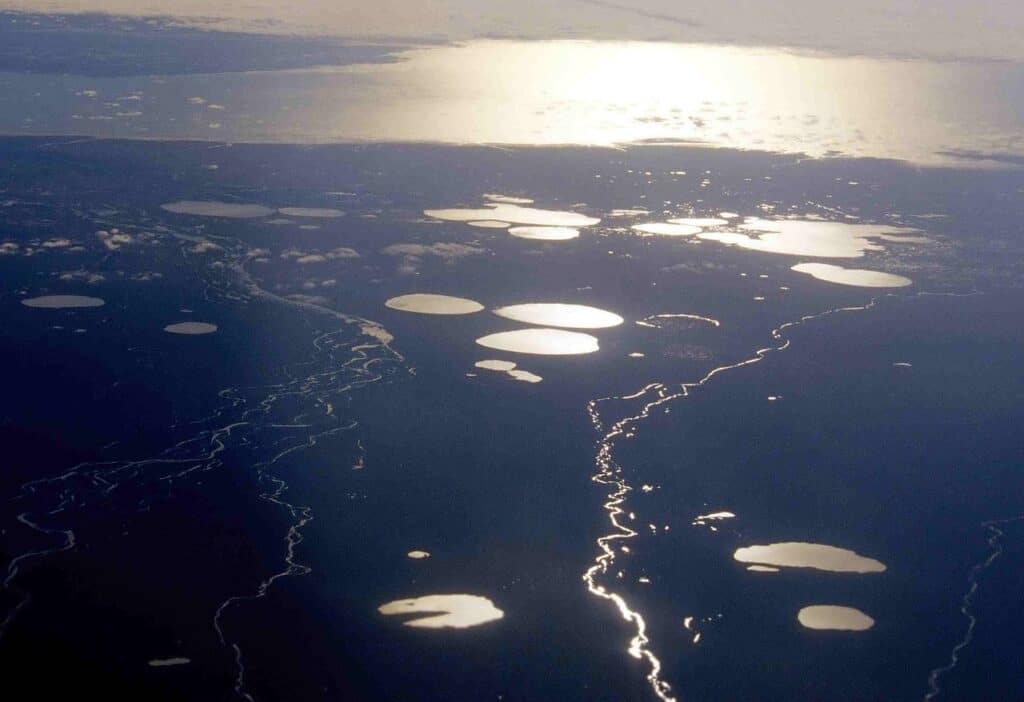
Spanning an area of 1,956 square miles, Nettilling Lake is Nunavut’s largest lake and also one of Canada’s largest lakes.
Nettilling Lake is a frigid freshwater lake in Canada with 1,956 square miles (5,066 square kilometers). Nettilling, Nunavut’s largest lake, is fed by several smaller lakes and streams. Only three species of fish have been reported in its ice-covered waters for most of the year: Arctic char and two stickleback species. Caribou thrive in the area surrounding the lake.
11. Lake Winnipegosis

Supplied by numerous small streams, Lake Winnipegosis spans 2,070 square miles.
Lake Winnipegosis is a large lake in western Manitoba, Canada, located between Lake Winnipeg and the Saskatchewan border. The 2,070-square-mile (5,370-square-kilometer) lake receives water from several tiny rivers on the west side and drains into Lake Manitoba and Lake Winnipeg. Although the lake’s pike, walleye, sauger, and perch numbers have been falling, significant efforts have been made to restore specific populations to typical levels.
10. Reindeer Lake
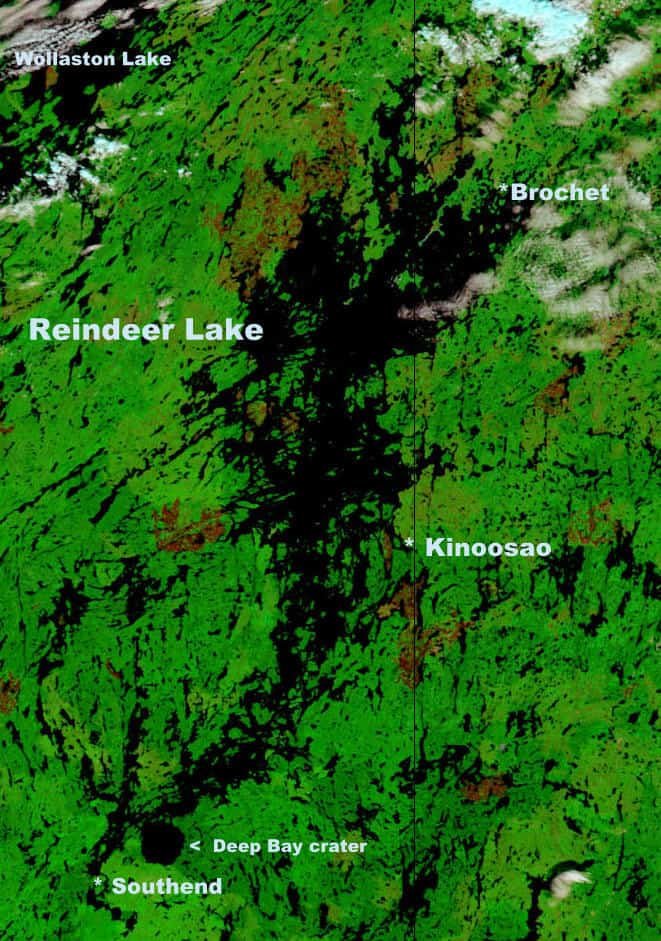
Reindeer Lake covers an area of 2,180 square miles and is the world’s 24th largest lake by surface area.
©Jacques Descloitres, MODIS Land Rapid Response Team, NASA/GSFC / This file is in the public domain in the United States because it was solely created by NASA. NASA copyright policy states that “NASA material is not protected by copyright unless noted”. (See Template:PD-USGov, NASA copyright policy page or JPL Image Use Policy.) – Original
In western Canada, Reindeer Lake ranks as one of North America’s largest lakes by surface area, measuring 2,180 square miles (5,650 km2). It’s also the continent’s tenth deepest lake, with up to 720 feet (220 meters). It is the world’s 24th largest lake by surface area, located on the Saskatchewan-Manitoba border. Because it is one of Canada’s largest lakes, the lake is vital to its fishing sector. Sports fishers love it because of its clear, deep waters.
9. Smallwood Reservoir
Smallwood Reservoir is a freshwater body in Canada that covers 2,520 square miles (6,527 square kilometers) and is located on the remote Labrador Plateau near the Québec border. It is Canada’s largest reservoir and the world’s second-largest reservoir by surface area. There have been record-breaking catches in the lake – notably the 22-pound landlocked salmon.
Northern pike, lake trout, brook trout, and whitefish are some of the other prominent fish in the Smallwood Reservoir. If you love hunting, you’ll delight at the sight of moose, caribou, black bears, wolves, coyotes, geese, and a variety of other local birds.
8. Lake Athabasca
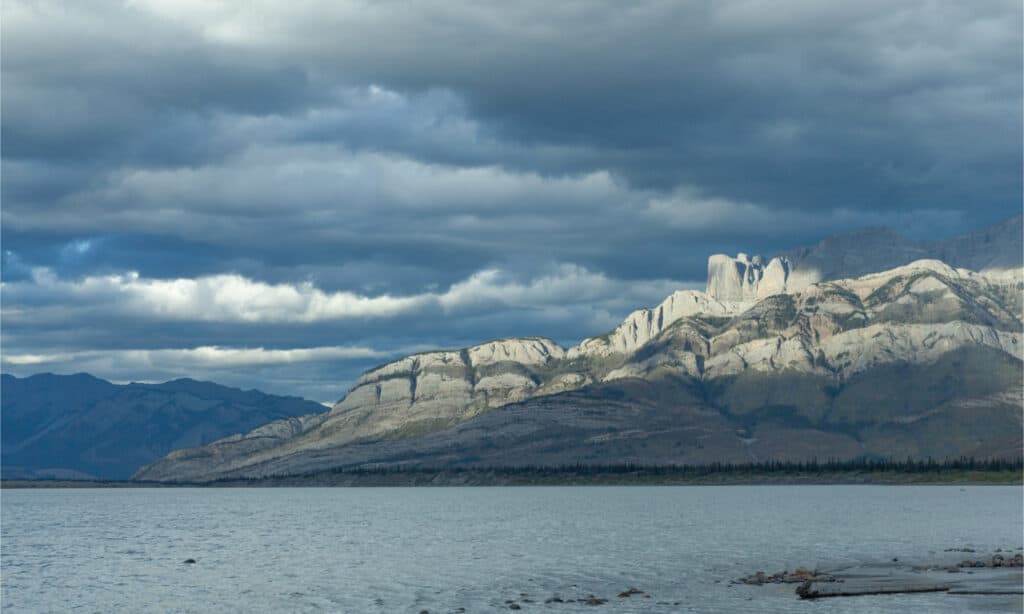
Measuring an area of 3,030 square miles, Lake Athabasca is one of Canada’s biggest lakes and it is also famous for its excellent fishing!
©Vladislav Mavrin/Shutterstock.com
Lake Athabasca is a massive lake in Alberta, Canada, with a surface area of 3,030 square miles (7,850 square kilometers). It’s also one of the continent’s deepest lakes, with a maximum depth of 407 feet (124 meters) at its deepest point. The lake is famous for its excellent fishing and is vital to commercial fisheries. Some fish found in the area include whitefish, lake trout, goldeye, walleye, yellow perch, and northern pike. The lake’s north bank served as a significant uranium and gold mining center.
7. Lake Ontario

Out of the five great lakes, Lake Ontario is the smallest in terms of surface area.
©Michael J. Eves/Shutterstock.com
Lake Ontario is a large lake in Canada shared by the province of Ontario and the state of New York. It is 7,340 square miles (18,960 square kilometers) in size. While Lake Ontario is the smallest of the five Great Lakes in terms of surface area, it is among the deepest lakes in the United States. Lake Ontario also features one of the deepest spots in North America, with 802 feet. It also has the lowest elevation of all the Great Lakes, at 243 feet above sea level.
6. Lake Winnipeg

Lake Winnipeg covers an area of about 9,465 square miles and a maximum depth of 118 feet only!
©lastdjedai/Shutterstock.com
In Manitoba, Canada, Lake Winnipeg is a large, shallow body of water. It has a maximum depth of only 118 feet (36 meters) and covers an area of around 9,465 square miles (25,514 square kilometers). It is most known for its beautiful white-sand beaches, popular with Manitoba residents throughout the summer months. Many fish and several important commercial fisheries can be found in Lake Winnipeg. The majority of Manitoba’s $30 million fishing industry comes from this lake, primarily in the form of goldeneye.
5. Lake Erie
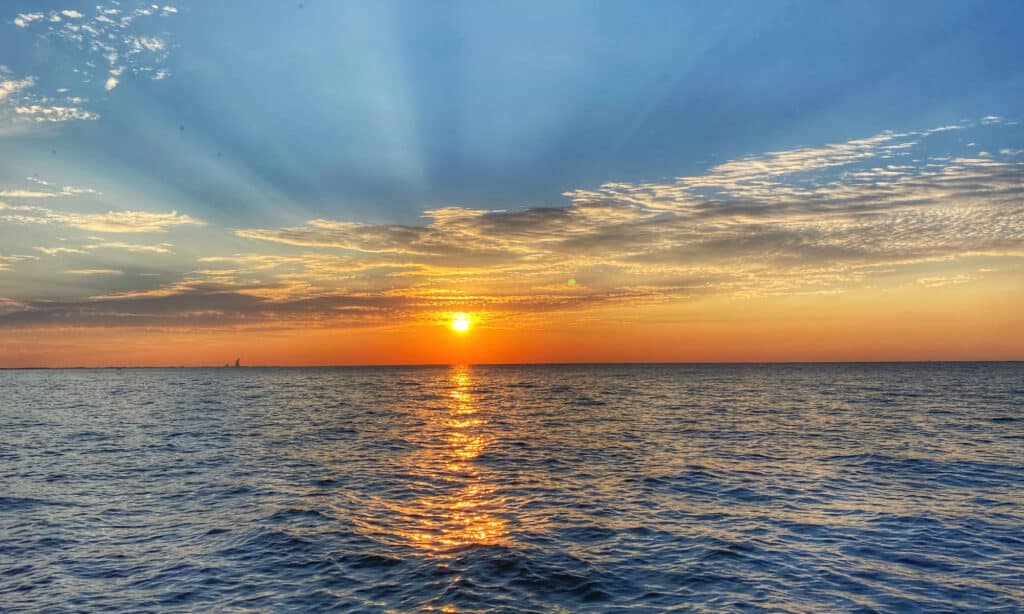
The fourth largest of the Great lakes, Lake Erie, covers an area of 9,910 square miles.
©iStock.com/becky johnson
Lake Erie is the fourth-largest among the Great Lakes, ranging from Ontario, Canada, through Pennsylvania, Ohio, New York, and Michigan, in the United States. The general area of Erie is 9,910 square miles (25,667 square kilometers). It is among the deepest lakes in the United States while being the shallowest of the Great Lakes, with a maximum depth of 210 feet (64 meters). Because it serves as a border between Canada and the United States, Lake Erie is a prominent geographical feature in North America.
4. Great Slave Lake

Canada’s second largest lake fully within its borders, Great Slave Lake, is also the world’s eighth deepest lake.
©norikko/Shutterstock.com
The Great Slave Lake in Canada is the deepest and fifth-largest lake on the North American continent. Boasting a surface area of 10,502 square miles (27,200 km2), it is also Canada’s second-largest lake fully within its borders. With a maximum depth of 2,014 feet, the lake is also the world’s eighth deepest lake. The lake is surrounded by vast bays and rocky hills in Canada’s Northwest Territories, and its principal water source is the Slave River, emptying into the Arctic Ocean via the Mackenzie River.
3. Great Bear Lake

Great Bear Lake is the fourth-biggest lake in North America and the largest lake entirely within Canada.
©Kevin Lings/Shutterstock.com
With a total surface size of 12,028 sq mi or 31,153 km2, Great Bear Lake is the fourth-biggest lake in North America and the largest lake entirely within Canada. With a maximum depth of 1,463 feet, Great Bear Lake is one of North America’s top 10 deepest lakes. The Great Bear Lake is a good home for freshwater fish, especially the rare speckled trout, due to its uneven shape and numerous small islands. The lake is named after the grizzly bear, one of its remarkable inhabitants. Moose, musk-ox, fox, and wolverine are among the animals found in its vicinity.
2. Lake Huron
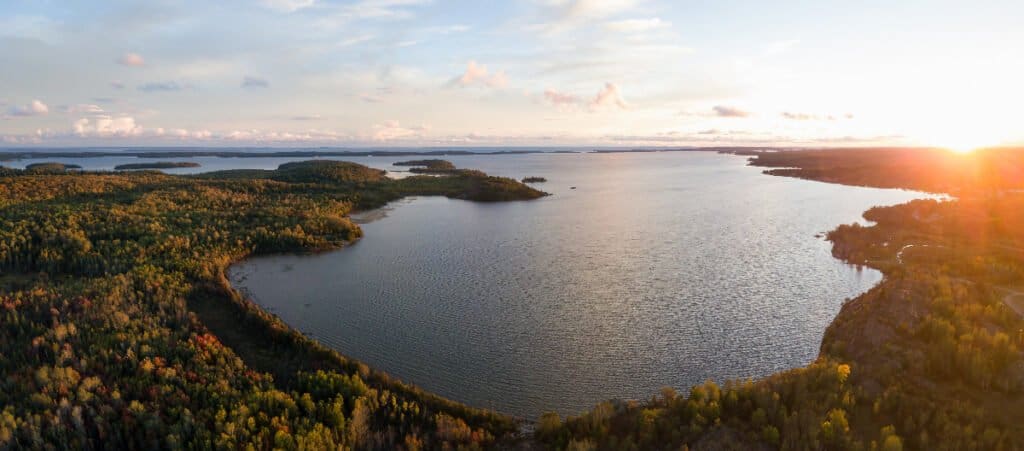
Out of the five Great lakes, Lake Huron boasts the longest shoreline.
©EB Adventure Photography/Shutterstock.com
Lake Huron is part of the Lake Michigan–Huron basin and has the same elevation as Lake Michigan (577 feet). It crosses the border between the US state of Michigan and Canada’s province of Ontario. Lake Huron and Lake Michigan are connected by the Channel of Mackinac, a 5-mile-wide, 120-foot-deep strait. The lake is 23,007 square miles (59,588 square kilometers) in size and boasts the Great Lakes’ longest shoreline at 3,827 miles with 30,000 islands. Lake Huron, the second-largest of the Great Lakes and the fourth-largest lake on the planet by surface area, is known for its breathtaking beauty.
1. Lake Superior
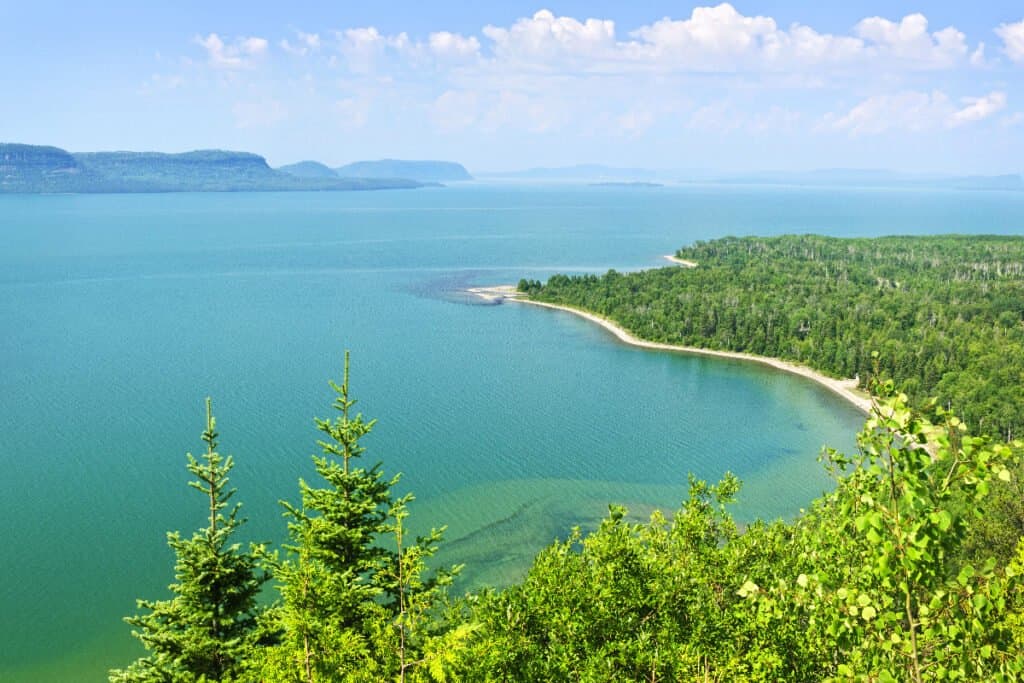
The biggest lake in Canada is Lake Superior.
©Elena Elisseeva/Shutterstock.com
Lake Superior is, without a doubt (and as its name says), the largest lake in North America and the biggest touching Canada’s borders. Lake Superior is the largest of the five Great Lakes in surface size, comprising 31,700 square miles (82,103 square kilometers). The lake stretches from Ontario, Canada, to Wisconsin, Minnesota, and Michigan’s Upper Peninsula. The name “Lake Superior” pertains to the lake’s enormous size and remote position. It is well-deserving of its throne because it holds 10% of the world’s freshwater.
Thank you for reading! Have some feedback for us? Contact the AZ Animals editorial team.








